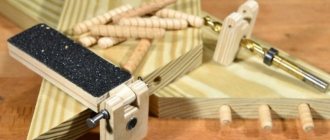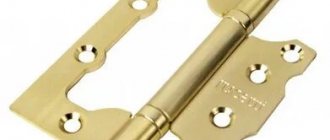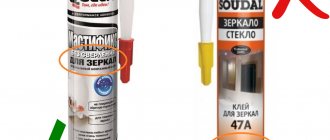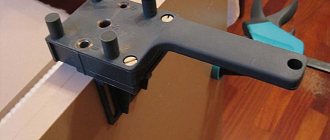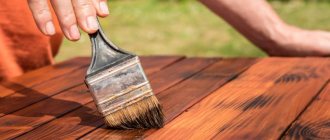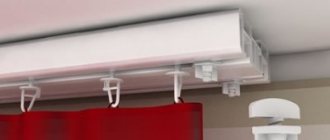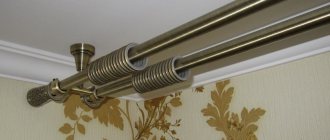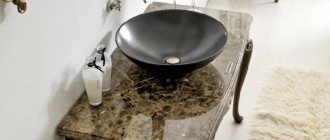Sometimes at home you need to make holes in blanks made of wood, metal, chipboard or other material.
And the presence of a screwdriver does not help and does not allow making holes strictly at an angle of 90, we are not talking about oblique holes at different angles.
To facilitate the processing of materials, a drilling jig is used.
These devices are widely used in the furniture industry.
[contents]
What is a hole jig?
In the article below we will talk about a hole drilling jig - a simple tool that will help you easily and accurately drill the desired hole in parts (or products) of both wood and metal.
What is it? This drilling device looks like an ordinary strip, in which holes of different diameters are made, and at different angles. It's easy to work with. All that is needed is to position the jig at the required angle to the surface to be processed, and it will serve as a kind of “guide” for the drill. As you might guess, such a device for drilling at an angle is simply irreplaceable in any furniture production workshop, but it can also be used at home.
Drilling in two parts at the same time
This option is considered the most accurate and, moreover, the fastest. But in order to make a hole in two parts at the same time, you will need to fix them before drilling. To do this, you may need special clamps, clamps and other devices.
Hole Drilling Tools
In order not to mark 8 mm from the edge each time both into the layer and at the end, you can use a special device, which, by the way, is easy to make yourself.
It is a kind of wooden template with a metal sleeve for a drill inside.
It looks like this, see photo:
And this is a more professional thing:
Watch a short video on how to accurately drill holes in chipboard for confirmations and assemble furniture parts:
Design and types
So, we figured out that a jig is a template strip, the main purpose of which is to ensure accuracy when drilling holes in a variety of materials.
There are two types of conductors:
- A jig designed for drilling holes located perpendicular to the surface of the product.
- A jig made for drilling holes at an angle. It allows you to make a hole at the desired angle.
But this is a very rough and generalized classification. In fact, there are more types of conductors, differing in their design and purpose. In particular, the following types of these devices are distinguished.
Invoices
As you can easily guess from their name, such jigs are applied to the surface of the part or workpiece to be processed. They can be secured with special clamps or simply held with your hand while working.
Rotary
These are specially made templates that are intended for processing cylindrical workpieces. With the help of such jigs, it becomes possible to make not only perpendicular holes, but also to drill holes at different angles, since the rotating devices are equipped with special bushings that allow the jig to be installed at different tilt axes.
Universal
Here too the name literally speaks for itself. These drilling jigs are suitable for most types of work (except for specialized ones), so they are loved by workers in small industries, and even by those who do work at home.
Sliding
This type of jigs does not require their attachment to the surface in which the hole needs to be drilled. You just need to hold them with your hand (which can often not be very convenient).
Pinned
Unlike the previous type, such jigs are rigidly attached to the workpiece being processed. Although it is more convenient to work with, this type of device limits freedom of action.
Tiltable
And the last type of conductors is quite similar to the universal type. They are used when it is necessary to drill in different planes or at an angle.
Drilling for dowels
The hole for the dowels is made with an 8 mm drill. Also, in order not to drill through the part, it is advisable to equip it with a depth limiter.
At the end we drill with the same drill to a depth of 20 mm. Do not forget that during any work the drill must be strictly perpendicular to the plane of the part.
Of course, if you picked up a drill for the first time in your life, you won’t do very well. But this activity can be learned quite quickly.
When manufacturing cabinet furniture, there is a need to be able to accurately and quickly drill into the end of parts. As a rule, this need is due to the use of euroscrews (confirmations), in which holes with diameters of 4.5-5.0 mm (depending on the density of the plate) are drilled into the end of the parts to a depth of 35-55 mm (depending on the length of the euroscrews).
Of course, there are special drilling and attachment machines for such purposes, but they are not readily available to private furniture makers or small organizations due to their high price, plus, the machines are not convenient due to exclusively stationary use. To simplify the work of a furniture maker, jigs were invented - small devices for precise drilling with a conventional hand-held electric drill. Today there are several manufacturers on the market; by paying quite a price, you can buy a ready-made conductor. This article will discuss how you can make a good homemade conductor from available and easily accessible material in a couple of hours. We use ball bearings to guide the drill bushings. The bearings are made of durable steel and will last a long time. In order for the drill to be well oriented in the jig, two bearings are used for each working distance (the bearings are located coaxially one under the other).
Materials from which conductors are made
There are many conductors that are made from completely different materials. There are even plastic and glass conductors.
However, the generally accepted opinion is that the best devices are made of metal (the best option is stainless steel).
This is not surprising, because a metal drilling jig can provide a number of advantages. Mainly among them, it is worth highlighting the clearest directionality of the drill, virtually no deformation, and also the fact that metal conductors do not heat up during operation.
A few words about the design of a water well
Disassembling the device of the correct well design, we can highlight:
*Working column – internal, operational, where a centrifugal pump is installed.
*Technical or intermediate column - it is necessary to ensure that during drilling operations an accident does not occur and the well does not collapse. The material is not important here, because after completion of the work it is usually removed from the well.
*Conductor – external column. What is its difference?
Advantages and disadvantages
The main advantage of conductors is that not even highly qualified specialists, but “ordinary” people at home can work with them. And they will produce clear and precise holes (both perpendicular and inclined).
You will not need to perform any calculations and markings, and this reduces how
labor intensity and work time.
The following advantages of using this type of device can be highlighted:
- The drilling jig is capable of providing perfect accuracy for both straight and inclined drilling.
- To use them, markings and preliminary scrupulous calculations are not required.
- Speeding up the assembly of furniture parts and other structures.
- The ability to drill several holes at a time without making preliminary markings.
disadvantages of drilling jigs ; to be more specific, there is only one: the rather high price of this device. That is why some carpenters make their own jigs.
General purpose
The scope of application of drilling jigs is not limited to carpentry and furniture assembly. Thus, the already mentioned KWB Dubelprofi and similar devices are ideal for drilling holes on flat surfaces, for example for fastenings in walls. Jigs with a V-shaped groove on the base are practically the only tool that allows you to quickly and accurately drill into a round pipe or into a rectangular edge of a part.
The need to drill strictly perpendicular holes in concrete and brick walls often arises when making openings or the need to bypass hidden technological channels or reinforcement. In the simplest case, you can use Wolcraft Tecmobil or KWB 7778 drill stands for these purposes; these devices are also designed for desktop use. In the case of making holes of significant diameter, devices such as Mechanic Distar, designed also for drilling with pobedit bits, are very helpful; in the same series there are convenient dust collector casings.
The most serious and highly specialized jigs are called diamond drilling racks. In this segment you can find both budget options, such as Titan NS 1000, and expensive devices from Bosch and AGP. A distinctive feature of such jigs is the presence of a split coupling for attaching the spindle neck of a drill or hammer drill, or a specialized drilling machine. The jigs also have a mechanical feed device, which is a mandatory requirement when using diamond bits.
Scope of application
Jigs designed for drilling holes are widely used in furniture manufacturing, but their use is by no means limited to this industry.
Let's take a closer look at where this useful device is used.
Furniture manufacture
When making furniture, it is constantly necessary to drill holes for accessories, fasteners, and fittings. After all, it’s enough to make a mistake with the hole by literally a couple of millimeters, and the cabinet or bedside table will turn out skewed during assembly. The finished product will have to be thrown away or it is unlikely to be sold.
Therefore, jigs are simply necessary in the production of furniture, because they “correct” the incorrect angle of the drill entering the part. Also, when assembling furniture, a jig for drilling holes for dowels or a template for drilling holes for confirmation has proven itself to be excellent.
Mechanical engineering
Here, jigs are used for drilling holes in a variety of workpieces made of various materials. Since everything is standardized in this industry, the slightest discrepancy in dimensions leads to rejection of the part. Therefore, there is simply no way to do without conductors in this area.
Construction
During any construction work, you always have to make holes in walls, ceilings, and fasten various parts. If you do not use templates, the drilling process will be delayed, since it is much more difficult to make holes in the walls or ceiling at exactly the right angle. Therefore, builders often use a jig to drill holes at an angle.
Serial or mass production
Mass production requires unification of components. Accordingly, conductors will come in handy here too. When using these tools, you are confident that all holes will be the same.
Household use
Every home needs repairs from time to time. In this case, you often have to pick up a drill and make holes in walls or furniture, and here, just like air, conductors will be needed.
Hole depth and width
When assembling furniture, confirmat size 6.4*50 is usually used. Because the thread diameter is 6.4 mm, and the diameter of the confirmation body is 4.4 mm, then for high-quality fastening of parts, the hole diameter must be in the range of 4.5-5 mm and a depth of at least 50 mm.
If the thickness of the hole is greater than the specified one, the confirmat will not hold the parts well; if it is less, its thickness can tear the chipboard.
For drilling, use a confirmat drill with a diameter of 4.5 mm, which is equipped with an additional head for drilling an enlarged hole for the neck of the confirmat, which also makes a countersink for its head.
Of course, you can use a regular drill with a diameter of 5 mm, but for high-quality fastening in the hole you will additionally need to make space for the neck of the confirmat and its head.
Homemade conductors
Since drilling templates aren't exactly cheap, many people make their own. Yes, a jig for drilling holes with your own hands is not a fantasy, but a reality.
In order to make a conductor, you will need:
- drawing or diagram of the device;
- drill;
- welding machine;
- Bulgarian;
- locksmith tools;
- “blank” for the future conductor (reinforcement with a square section of 10x10 millimeters is good).
First, we cut the reinforcement with a grinder (a hacksaw is also suitable) into pieces of the required length, which are cleaned with sandpaper. Then marking of future template holes is done and their subsequent drilling. There are some nuances here. The centers of the holes should be marked 8 millimeters from the edge, the distance between the holes should be (according to generally accepted standards) 32 millimeters, and the diameter of the holes should be 5 millimeters.
At the end, we add a stop made of a metal plate (25 millimeters wide and 1 millimeter thick), bent at a right angle. We fasten all parts of the contraction together - and the jig for drilling with your own hands is ready.
An efficient tool for creating holes
If you need to create a series of holes on an aluminum profile structure to install quick connectors, then the optimal solution would be to buy a hole drilling jig. Homemade equipment will require a labor-intensive manufacturing process. In addition, elements not made using high-precision equipment lack factory precision and installation of quick connectors will be problematic or impossible.
sells aluminum profiles and various components. The store's assortment allows you to select high-quality and reliable jigs for drilling holes. Hole drilling tools are a great way to make installing quick connectors easier and faster.
Still have questions? Need some advice? In this case, dial our number -. The manager will give a comprehensive answer to all questions and help you choose the necessary components for your tasks!
What does a well consist of?
The following elements are distinguished in the construction of wells:
- Mouth – the upper part of the canal;
- Face – the lowest point of excavation, the bottom;
- Trunk – channel, drilled well cavity; pipes and equipment are located inside the shaft;
- The filter is the element that is in direct contact with the aquifer; Natural durable underground rocks or filter devices can be used as a filter.
The type of well is selected depending on the estimated water consumption. To ensure the life of an ordinary family and water a plot of 10 acres, 2 cubic meters of water per hour is sufficient. This volume will be provided by a sand well with a diameter of up to 120 mm. Higher water needs associated with the operation of washing machines, dishwashers, and irrigation require the lifting of significant masses of water - from 4 cubic meters.
To supply water to a private home, wells of various depths and diameters are used. The required well characteristics are determined before work begins. The most accessible, least expensive - both in production and in maintenance - is a sand well. Its depth is two tens of meters, which makes it possible to use inexpensive pumps: manual or vibration. The diameter of the channel is not significant, the main thing is that the hose with the filter passes through.

